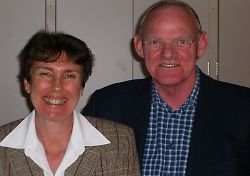FIG's Commitment to the UN-Habitat Global Land Tool Network
The UN-Habitat Global Network for Development of Innovative Pro-Poor
Land Tools, Workshop in Oslo, Norway, 23-24 March 2006
 |
Dr. Clarissa Augustinus, Chief of the Land and
Tenure Unit, UN-Habitat, and Prof. Stig Enemark, Vice-President
of FIG, during the UN Habitat Workshop in Oslo. |
Vice-President Stig Enemark attended the UN-Habitat workshop in
Oslo 23-24 March 2006 to present the FIG commitment to the UN-Habitat Global
Network for Development of Innovative Pro-Poor Land Tools.
The workshop was jointly organised by UN-Habitat, the Norwegian Ministry
of Foreign Affairs, the Norwegian Agency for International Development
(NORAD), and the Swedish International Development Cooperation Agency
(Sida). About 100 participants attended the workshop by invitation
representing various land right related organisations throughout the world
being potential partners of the Global Land Tool Network.
The first half day was organised by the High Level Commission for Legal
Empowerment of the Poor (HLCLEP). The High Level Commission is chaired
jointly by Dr. Madeleine K. Albright, former Secretary of State, USA,
and Mr. Hernando de Soto, President of the Institute for Liberty and
Democracy, Peru. Presentations very given, among others, by Mr. Naresh
Singh, Secretary General of the High Level Commission, Mrs. Anna K.
Tibaijuka, Executive Director of UN-Habitat in her capacity as member of
the Advisory Board to the HLCLEP. The key objective of the commission is to
generate political support for broad reforms that will ensure legal
inclusion and empowerment of the poor including fungible property rights for
their assets and access to credit and capital. The meeting discussed
different options of how HLCLEP will work together with the GLTN for
developing a comprehensive set of practical, adaptable tools that will guide
policymakers´ reform efforts at the country level. Further information on
High Level Commission can be found a
www.undp.org/legalempowerment/html/commission.html
The following one and a half day focused on the Global Land Tool Network
(GLTN) with Dr. Clarissa Augustinus, Chief of the Land and Tenure
Section at UN-Habitat, playing a key role. A range of presentations were
given to introduce and discuss various mechanisms of the GLTN such as peer
review mechanism, gender mechanism, grassroots mechanism and dissemination
mechanism. Also, a range of partner presentations were given on ongoing and
planned land tool programmes and initiatives world wide.
FIG Vice-President Stig Enemark presented the FIG commitment to the GLTN
which is in line with the general commitment of FIG – especially within
Commission 7 and 8 – for developing and promoting the concept of land
administration systems for sustainable development where special attention
has been given to good governance, gender issues, and pro-poor land tools.
The contribution of FIG to the GLTN will be mainly in the area of analysing
and designing adequate land administration systems that include relevant
pro-poor land tools, promote social inclusion, and support sustainable
development. The project on developing a Social Tenure Domain Model can be
seen as such an example of and FIG contribution to the GLTN. The project was
presented at the recent FIG Regional Conference in Accra, Ghana.
The main objective of the GLTN is to facilitate the attainment of the
Millennium Declaration and the Millennium Development Goals through improved
land management and tenure tools for poverty alleviation and the improvement
of the livelihoods of the poor. The core values of the GLTN are pro poor,
governance, equity, subsidiarity, affordability, systematic large scale
approach and gender sensitiveness.
Six themes are identified for land tool development: Land rights and
records; Land information/planning; Land management/administration; Land law
and enforcement; Land tax/valuation, and Cross cutting issues (such as
capacity building, gender issues, etc.).
UN-Habitat will play a central role in coordinating the network at global
level, but designated experts and institutions outside the UN will undertake
the tasks of conducting research and tool development, and of managing the
other ongoing activities of the network. It is the intention of UN-Habitat
that this network will scale up over time, building the capacity required to
support Member States, regional offices, civil society organisations, and
other key stakeholders in advancing the attainment of the Millennium
Development Goals. The GLTN will be officially launched during the third
session of the World Urban Forum in Vancouver 19-23 June 2006.
|
The Social Tenure Domain Model
Land is the key issue behind slum formation. Addressing the slum
challenge means taking the land issue seriously. Given that experience
has shown that it takes 15-25 years to change a country's land
administration system, we cannot afford to wait if we wish to improve
the lives of slum dwellers now in the short-term.
Many people think that the way to solve the problems of insecurity of
tenure, homelessness and the development of slums is through large scale
land titling. While this approach is of course important and necessary,
it is not enough on its own to deliver security of tenure to the
majority of citizens in most developing counties, especially in Africa.
Land administration systems with colonial roots do not really support
the registration of customary or informal rights. This means that
socio-technical innovations are required. It should be noticed that in
the technical field, there is often an insufficient focus on pro poor
technical and legal tools. In the development of the FIG Core Cadastral
Domain Model, efforts are being made to avoid such criticism.
This pro poor approach is being strengthened by undertaking further
research into domain modeling, especially in regard to the proposed
Social Tenure Domain Model as a specialization of the Core Cadastral
Domain Model. |
Stig Enemark
14 April 2006 |























